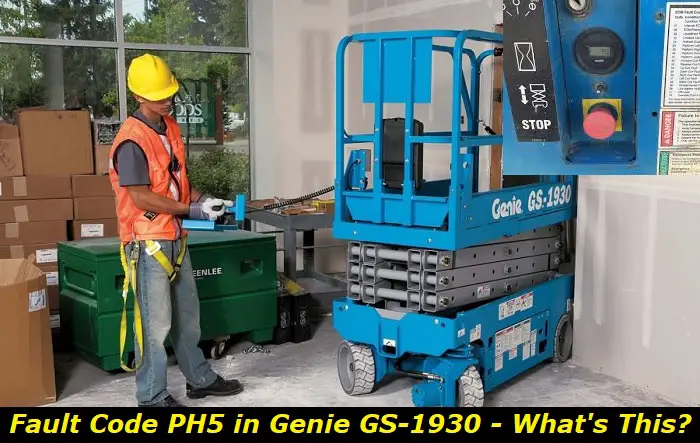Genie GS-1930 PH5 Code: Understanding, Troubleshooting, and Preventing
Understanding the intricacies of fault codes in heavy machinery such as the Genie GS-1930 is crucial for any experienced mechanic. Diagnostic codes assist us in identifying specific issues and undertake targeted solutions. Specifically, the PH5 code in a Genie GS-1930 is a diagnostic alert that plays an essential role in the machine's maintenance and smooth running. It serves as a signal highlighting individual concerns that need immediate attention to avoid potential operational decline or costly damage.
Therefore, this article elaborates on the importance of the PH5 code, its potential causes, and the necessary troubleshooting steps. Moreover, it also provides insight into preventive maintenance strategies, aiding in avoiding recurrent PH5 issues and ensuring overall equipment efficiency and longevity. With this knowledge, mechanics can promptly respond to PH5 code indications, maximizing the Genie GS-1930's performance while minimizing unexpected machine downtime.

The Importance of Diagnostic Code
As an experienced mechanic, I can attest that the realm of heavy machinery, especially involving a machine as grand as the Genie GS-1930, is incredibly complex and diverse. One system that stands out in importance is the diagnostic code system. Diagnostic codes, such as the PH5 code, serve as our technological language, communicating the systems' status and any pertinent issues that need to be addressed.
Consider the PH5 code as an eloquent dialogue between your machine and you. It's not just a random grouping of alphanumeric characters. Significantly, the PH5 code is a clear and prioritized invitation for necessary maintenance. When you see this code pop up, understand it as your Genie GS-1930 saying, "Hey, I need your attention here."
Researching the technical specifics, the PH5 code points towards a particular area of concern within the Genie GS-1930. Unpacking its intrinsic significance, the PH5 code usually indicates an issue with the lift's function, signifying a possible problem with the platform control system. In a nutshell, if your machine generates a PH5 code, it's primarily a cautionary flag for you to reassess the platform control's operations and connections swiftly.
It's important to remember that kicking into action at the sight of a PH5 code can have direct positive implications on your machine's operational effectiveness. Timely action can help rectify an existing issue, preventing it from escalating into a potentially costly and hazardous situation. Ultimately, understanding the cry for help signaled by a PH5 code can keep your Genie GS-1930 running smoothly, delivering consistently high performance while ensuring the safety of its operator.
The Causes of Genie GS-1930 PH5 Code
Decoding the underlying issues that lead to the PH5 error code can seem challenging. However, as experienced hands in heavy machinery, it is crucial to appreciate the possible problems prompting this error code, increasing our proficiency in addressing the situation.
In the context of a Genie GS-1930, the PH5 code is predominantly triggered by a fault in the Platform Control Box. This box serves as the primary command center for the machine's operations, housing the joystick and all the switches that control the scissor lift's functions. Hence, any malfunctions within it can result in a Genie GS-1930 registering a PH5 error code.
Several issues can cause the Platform Control Box to malfunction. These range from simple electrical issues, such as wiring faults or inadequate connections, to more significant concerns such as problems with the circuit board within the control box itself. Additionally, issues related to moisture or grime that accumulates within the control box over time can interfere with the box's capabilities, leading to the PH5 code.
It's noteworthy that age and wear can also contribute to this error, as these factors may cause the Platform Control Box's parts and internal mechanisms to degrade gradually. Understanding this allows one to have a comprehensive perspective on the PH5 fault, tackling it methodically and ensuring the smooth operation of the Genie GS-1930.
Troubleshooting the Genie GS-1930 PH5 Code
From the seasoned technicians to the newest trainees, everyone knows that the real-time scenario of diagnosing and troubleshooting a machine is a test of knowledge and experience. Let's take a step onto the factory floor together and delve into the practical process of troubleshooting the Genie GS-1930 PH5 code.
Understanding that the PH5 code is generally triggered by a particular malfunction is the first stride. Often, the PH5 code is activated when the platform control deadman switch is not functioning as required. As a result, it's always a good idea to begin by verifying and testing this element.
To tackle the PH5 code, you'll need a multimeter, a simple yet powerful tool found in every mechanic's toolbox. Using this tool, you can measure the resistance and continuity of the deadman switch. If the readings are abnormal, this may indicate a faulty switch. Be sure to pay careful attention not to overlook loose wiring connections, as these can cause the PH5 fault code as well.
If the deadman switch appears normal, and no loose connections are detected, the next step is to examine both the platform and ground control modules. These are the nervous systems of the Genie GS-1930, signaling every move the machine makes. Keep in mind, an error here could easily lead to a cascade of other problems, including the PH5 code.
While examining these elements, pay special attention to signs of visible damage or corrosion. If you discover any damage or corrosion, the problematic component will need to be repaired or replaced promptly to restore smooth and safe operation of your Genie GS-1930.
Ultimately, remember that each piece of equipment is unique, and the PH5 code may require a specific, tailored solution. Being patient, systematic, and not skipping any steps during the process is the best approach to effectively troubleshoot the Genie GS-1930 PH5 code.
Maintenance Tips to Avoid Genie GS-1930 PH5 Code
If you're keen on optimizing the performance of your Genie GS-1930 and ensuring a more reliable operational lifetime, preventive maintenance becomes a guidance beacon. Such a proactive approach helps avoid encountering repeated instances of the PH5 code, which implies an underlying issue that needs to be addressed.
Regular check-ups of the entire system is a commendable routine. It involves assessing the chassis for any signs of wear or tear as well as inspecting mechanical, hydraulic, and electrical components. Also, don't overlook the battery, ensuring it is clean, corrosion-free, and efficiently charged demonstrates its impacts on the overall system performance.
Symmetry in checking the hydraulic fluid levels is also essential. Low levels can cause the machine to function inefficiently, and the PH5 code could be generated as a result. If required, you should promptly replace the hydraulic fluids along with regularly cleaning or replacing hydraulic filters which can prevent contamination.
Understanding the sensor system holds the potential to a more breathable operation. Sensors in your Genie GS-1930 serve a crucial role in detecting abnormal activity in the machine. Indeed, it is important to maintain these sensors and ensure they are functioning correctly. Keeping an eye out for signs of damage or misalignment in these units can help prevent errors, including the PH5 code, as these issues can sometimes generate false positives.
Moreover, attention to the platform controls is another precaution. They should be examined for any static electricity buildup since it can lead to faults, including the PH5 code.
Remember, the key to avoiding the PH5 code lies in the continuity of your precautionary measures. Engaging with these regular checks, along with addressing any concerns immediately, can help prevent major equipment failures and contribute in keeping optimal machine health.

Add comment